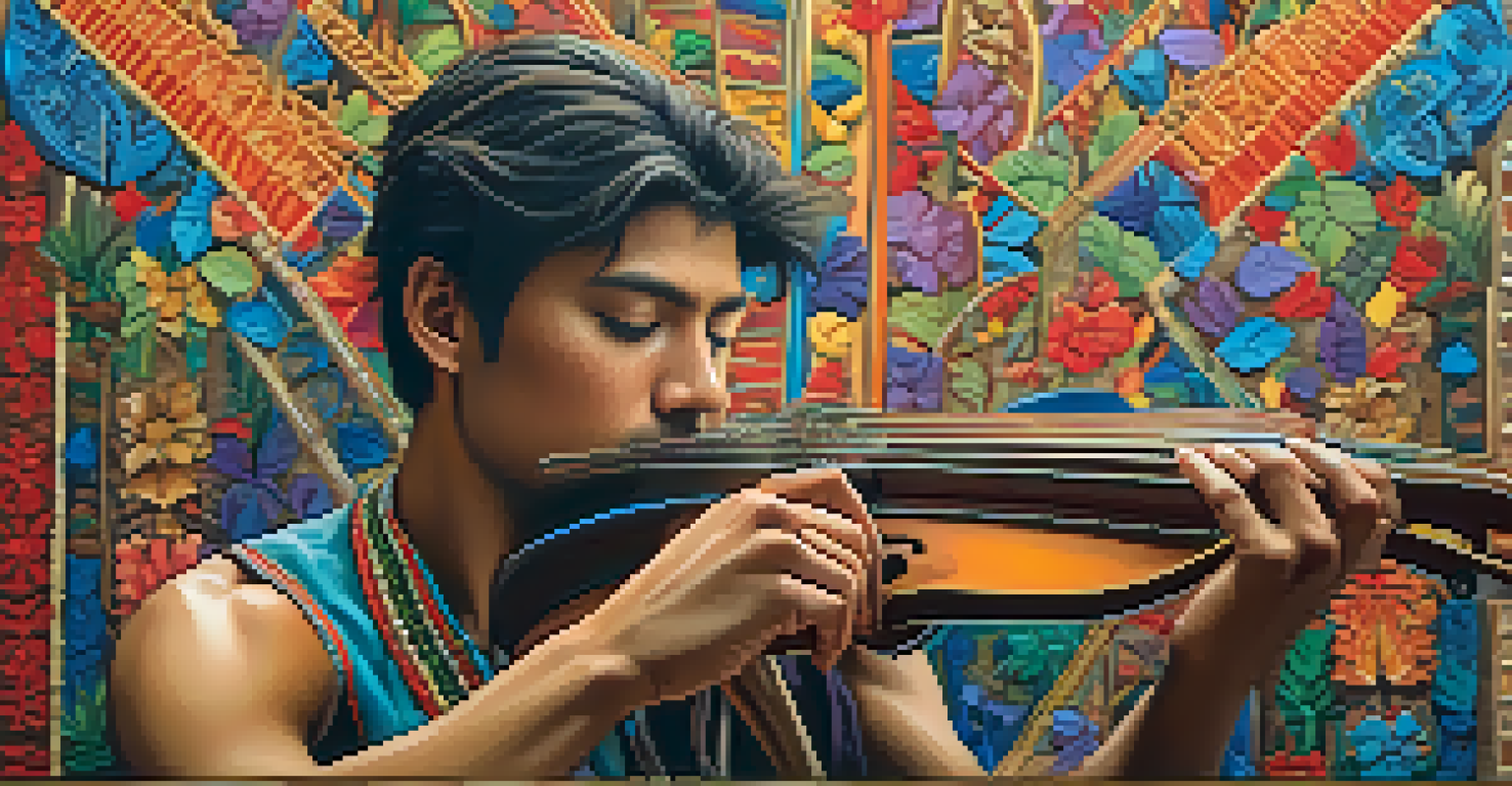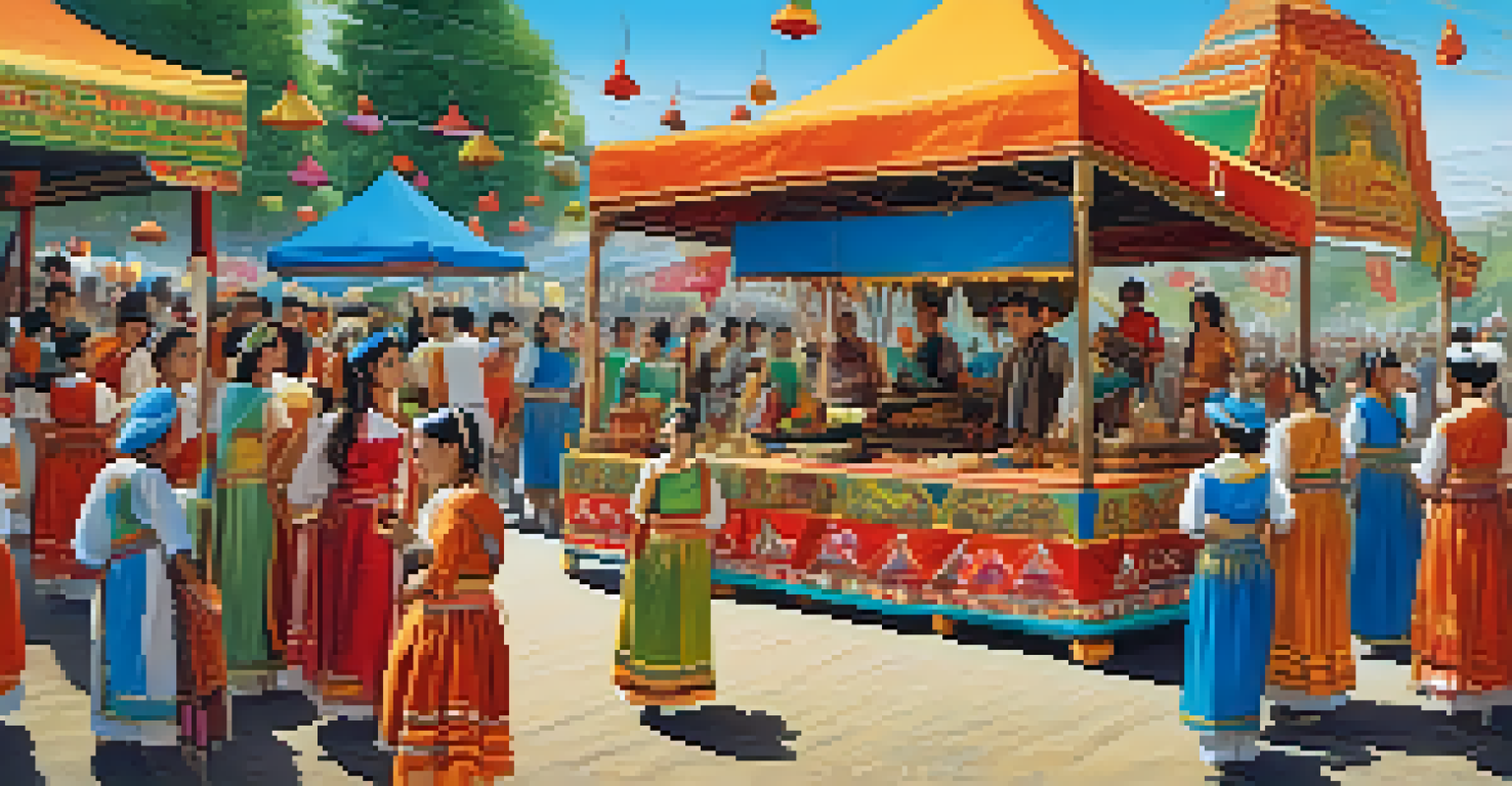Cultural Appropriation in Art: Balancing Influence and Identity

Understanding Cultural Appropriation in Art
Cultural appropriation in art refers to the adoption of elements from one culture by artists from another, often without permission. This practice can lead to the commodification of cultural symbols, which can be problematic and disrespectful. For instance, when a fashion designer uses traditional patterns from a marginalized group without understanding their significance, it can feel exploitative. It's important to recognize that cultural exchange can be positive when approached with respect and understanding.
Cultural appropriation is the act of taking or borrowing from a culture without permission or understanding. It can lead to the commodification of cultural symbols, which can be problematic and disrespectful.
Differentiating between cultural appropriation and appreciation is key. While appreciation involves learning and honoring another culture, appropriation often ignores the context and significance of cultural elements. An example of appreciation might be an artist who collaborates with a cultural community to create art that reflects shared values and stories. This distinction is vital for fostering respectful and meaningful interactions between cultures in the art world.
The conversation around cultural appropriation is not just academic; it resonates deeply with the identities and histories of people. Artists must navigate these waters carefully, ensuring their work contributes positively to the cultural narrative rather than undermining it. This awareness can lead to more authentic and enriching artistic expressions that honor the cultures they draw inspiration from.
The Fine Line: Influence vs. Appropriation
Influence in art is a natural phenomenon; artists often draw inspiration from various sources. However, this influence can tip into appropriation when it lacks context or respect. For example, a musician might incorporate traditional rhythms from another culture, but if they fail to acknowledge the source, it can lead to accusations of appropriation. Thus, understanding this fine line is crucial for artists who want to celebrate diverse influences without crossing ethical boundaries.

Being mindful of the origins of artistic elements can help artists maintain respect for the cultures they engage with. Artists can benefit from researching the history and significance behind the motifs they wish to include in their work. This effort not only enriches the creative process but also fosters deeper connections between the artist and the cultures they draw from. When artists acknowledge their influences, they contribute to a more inclusive art community.
Cultural Appropriation Explained
Cultural appropriation in art involves adopting elements from another culture without permission, often leading to disrespect and commodification.
Ultimately, the goal is to create a dialogue between cultures rather than a monologue that sidelines the voices of indigenous communities. Artists should strive for collaboration and mutual respect, which can result in innovative and respectful expressions of culture. This approach not only honors the source material but also opens up new avenues for creative exploration.
Case Studies: Appropriation vs. Appreciation
Looking at real-world examples can illuminate the complexities of cultural appropriation. The use of Native American headdresses in fashion shows often raises eyebrows, as these headdresses hold deep spiritual significance. When they are worn as mere accessories, it can feel like a trivialization of their meaning, leading to backlash from Native communities. Such instances highlight the need for artists to consider the implications of their choices.
The goal is to create a dialogue between cultures rather than a monologue that sidelines the voices of indigenous communities.
Conversely, we can find inspiring examples of cultural appreciation in art. Take the work of artists who respectfully incorporate indigenous techniques while collaborating with the communities themselves. This can lead to vibrant art that honors the source material while also pushing creative boundaries. Such collaborations demonstrate how cultural exchange can be positive and enriching.
These case studies remind us that the intent behind artistic choices matters significantly. Artists should strive to engage with other cultures in a way that fosters understanding and respect. By doing so, they can create art that not only resonates with diverse audiences but also uplifts and honors the cultures that inspire them.
The Role of Education in Culturally Sensitive Art
Education plays a crucial role in helping artists navigate the complexities of cultural appropriation. By providing resources and training on cultural sensitivity, art institutions can foster a more inclusive environment. Workshops and discussions can equip artists with the tools needed to appreciate other cultures thoughtfully. This proactive approach can help prevent appropriation before it occurs, promoting awareness and respect.
Additionally, art educators can encourage students to explore their cultural identities and how these identities influence their work. This exploration can lead to a deeper understanding of the significance of cultural elements and the importance of ethical representation. Through education, artists can learn to celebrate their own heritage while also engaging with others in a respectful manner.
Importance of Cultural Education
Education is vital for artists to navigate cultural sensitivity, ensuring they appreciate and respect the cultural elements they incorporate into their work.
Ultimately, fostering a culture of learning and sensitivity within the art community can lead to more authentic expressions of creativity. Artists who are educated about cultural histories are more likely to create work that honors and uplifts diverse voices. This approach not only benefits the artists themselves but also enriches the art world as a whole.
Artists as Agents of Change
Artists have unique platforms from which they can advocate for cultural sensitivity and respect. By using their voices and creativity, they can raise awareness about cultural appropriation and its impact on marginalized communities. This advocacy can take many forms, from creating thought-provoking art to participating in community discussions. Artists can play a pivotal role in shaping public discourse around these important issues.
Furthermore, artists can support marginalized voices by collaborating with them in meaningful ways. By featuring these voices in their work, they can create a richer narrative that honors the complexities of cultural identity. This not only enhances their art but also amplifies the stories and experiences of those whose cultures are often appropriated.
In this way, artists can become agents of change, challenging the status quo and inspiring others to think critically about their own practices. By standing in solidarity with marginalized communities, they can help to foster a more equitable art world that celebrates diversity while respecting cultural boundaries.
Navigating the Digital Age: New Challenges
The rise of social media and digital platforms has transformed the way art is created and shared, but it also presents new challenges regarding cultural appropriation. In an age where images can go viral instantly, the potential for misrepresentation is higher than ever. Artists need to be especially vigilant about the cultural significance of the elements they incorporate into their work, as the reach of their art can have far-reaching consequences.
Moreover, online platforms can sometimes blur the lines between appropriation and appreciation. Artists may be influenced by trends without fully understanding their cultural origins, leading to unintentional appropriation. Therefore, it becomes essential for digital artists to engage in thorough research and dialogue before sharing their work. This mindfulness can help prevent cultural insensitivity and build a more respectful online art community.
Artists as Advocates for Change
Artists can use their platforms to advocate for cultural sensitivity and respect, fostering dialogue and collaboration with marginalized communities.
As we navigate this digital landscape, it is crucial for artists and audiences alike to engage in meaningful conversations about cultural representation. By fostering an environment of awareness and respect, we can collectively work towards celebrating diversity in art while avoiding the pitfalls of appropriation. This proactive approach can lead to a more inclusive and thoughtful creative space.
Towards a Respectful Artistic Future
Looking ahead, the art world has the potential to become a more respectful and inclusive space for all cultures. By prioritizing education, collaboration, and open dialogue, artists can work together to ensure that their practices honor the cultures that inspire them. This vision of the future encourages artists to embrace their identities while also cherishing the diversity that surrounds them.
Creating a respectful artistic environment requires ongoing commitment and reflection. Artists must remain open to feedback from the cultures they engage with, ensuring that their work does not perpetuate stereotypes or misunderstandings. This willingness to listen and learn is vital for fostering a genuine appreciation for diverse cultural expressions.

In conclusion, navigating the complexities of cultural appropriation in art is a collective responsibility. By balancing influence with respect and understanding, artists can contribute to a richer, more inclusive art world. As we move forward, let’s celebrate the beauty of cultural diversity while honoring the identities and stories that shape our artistic landscapes.